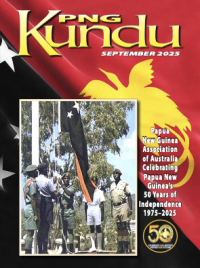Browse our Photo Galleries
Contributions are welcome and may be used in our quarterly journal. Please include date (approximate is fine), names and place. Permission to use photographs should be obtained from the authors or check with PNGAA. Following any approval to re-use photographs, both the photographer and PNGAA need acknowledging.
Comprising a collection of nine Galleries containing a total of 471 images covering gold mining activities in the 1930's; an account, with photos, of Queen Emma and family; early photos of Rabaul and environs during the German administration by an early Methodist Missionary; the Ian Skinner Collection of historic pictures of his experiences in the Central Highlands in 1938; as well as the Francis Lasker Collection, together with a series of 'Golden Oldies' by Chris Read; Rabaul, Kokopo and Port Moresby as seen through the eyes of Andrea Williams during 2008; a series of love letters written over a hundred years ago and a selection of paintings by artist Harly Dickinson


She kindly lent Kevin a series of letters written by Soren Nelson to his wife, a newspaper cutting from the North Queensland Register (circa 11 November 1907) and a number of photographs showing Samarai and part of the Trobriands, all taken circa 1906.
Mrs Pat Shea has kindly given permission for these to be reproduced on our web site.

Matupit was mesmerizing as it continually roared and erupted whilst we were there but we also visited the New Guinea Club which now houses a wonderful collection of historic memorabilia collated by the Rabaul Historical Society. We ventured up to Namanula, then over the Nordup Road to Tavui (Sub Base) where my father’s family home was located before WWII. On to Bitapaka War Cemetery, still a very beautiful and peaceful space to reflect on the tragedies touching Rabaul’s history. Finally Kokopo and the Ralum Club with the golf course and Queen Emma’s steps nearby, Vunapope Mission, the market, and the Kokopo War Museum. A highlight of our visit was a Bainings fire-dance - the fire crackled whilst the dancers responded to the crescendos of the singers and their continual beat.

He was a devoted pastor and a man of gentle nature. In the late 1920s he was appointed Chairman of the District, but this administrative position, in which hard decisions had sometimes to be made or persons disciplined, did not suit his nature, and he was glad to return to pastoral work when another Chairman was available. When Rabaul’s indigenous workers went on strike for higher wages in 1929, they gathered at Catholic and Methodist Mission centres on the outskirts of Rabaul. Margetts listened sympathetically to those who gathered at the Methodist centre, Malakuna, and visited the Administrator’s office to plead for them not to be punished. He then advised the strikers to return to work; when they said they were afraid they would be beaten, he personally shepherded them back to their places of work in the town, again pleading for them to be treated leniently. For this, he was verbally attacked by many Australian residents, and his pleas were generally disregarded. It was said that “He wasn’t a very effective Chairman, but he was so kindhearted he wouldn’t hurt a fly.” Margetts died at Kabakada on 14 July 1935, and was buried in the European Cemetery, Rabaul. He was survived by his wife Adelaide, who returned to Australia.
(Our thanks to Rev. Neville Threlfall for the above information)

Note that copyright of these photographs is vested in Frances' daughter, Anne Webster - all requests for use in publications or for any other commercial purpose should be referred to her through admin@pngaa.net.
Photos depict scenery, expatriate Australians and local inhabitants, predominantly in and around Port Moresby.

From PO through to holding a number of responsible Government positions:
PNG Magistrate, Highlands Land Council and Coroner to name a few.
On return to Australia he went into politics and was MLA (Lib.) for South Barwon 1982-92
He paints as a recreational pursuit.






